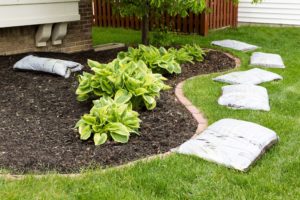
Remember these mulching best practices when preparing your landscape for spring.
As the warmer spring weather arrives, your lawn’s soil begins to recover from the freezing temperatures of winter. In general, spring is a great time to mulch your trees and shrubs and prepare them for the long summer ahead. The start of spring is just around the corner, so it’s a good time to prepare for mulching your landscape. You can do this by understanding mulching best practices, which will tell you how much mulch you will likely need and any other elements you need for successful mulching when the time is right. Read on to learn more about the essential tips to remember when mulching your landscape.
Apply the Correct Amount
Generally, when applying mulch, one to three inches is recommended. For new areas, two to three inches can be good, but that amount can be reduced to one to two inches for perennials. For annuals, the amount can be reduced to about one inch. Established garden beds may only need a touch-up for appearances.
Avoid Mulch Volcanoes
When mulching trees, it is essential not to create “mulch volcanoes.” These are created when mulch is placed up to the bark of the plants and trees. Bark decay can occur when mulch is left against the tree trunks or shrub stems for extended periods. This is because mulch causes continuous dampness, which encourages decay, and attracts insects, fungi, and bacteria to feast on the rotting wood. If wood rot develops, it can lead to the death of your plants.
Don’t Overdo It
Over-mulching is a common mistake. Watch out for mulch build-up, and discard or turn over excessive amounts of old mulch. Rodents can nest in excessive mulch, and if roots grow into large piles of mulch, they become prone to drought stress during dry periods and cold injury during freezing temperatures.
Add an Herbicide
When mulching in the spring, adding a pre-emergent herbicide may further benefit your landscape. A pre-emergent herbicide can help reduce summer-annual weeds and save you future time cleaning out those weeds from your landscape beds.
When In Doubt, Call for Help
If you want to be sure that you follow mulching best practices this spring, contact Scientific Plant Service for expert help. Our lawn and landscape professionals can help determine the ideal amount of mulch for your landscape, as well as the best herbicide if necessary. When in doubt, it’s best to call in help from the experts rather than risking doing anything that may hurt your landscape’s growth through the spring and summer.
Scientific Plant Service Is Your Go-To Source In Landscape Healthcare
Scientific Plant Service, located in Baltimore, is a privately owned corporation, chartered in Maryland in 1957 by Frank J. Burke. We started as a full-service Arborists specializing in the care of shade trees and ornamental shrubs, but today we are a Lawn Care company that is a huge part of the community. From aquatic environments and snow management to deer and mole control, SPS has services tailored specifically for your lawn and landscape.
We offer services in Maryland, Washington, DC, and Virginia, including: Harford, Baltimore, Carroll, Frederick, Howard, Anne Arundel, Montgomery, Prince Georges, Talbot, Queen Anne’s, Calvert counties in MD, as well as Loudoun County, Fairfax County, Arlington, Alexandria, and Falls Church in VA. For more information, contact us online, or call us at 410-321-0970. Be sure to follow us on Facebook, Twitter, LinkedIn, and Pinterest!

